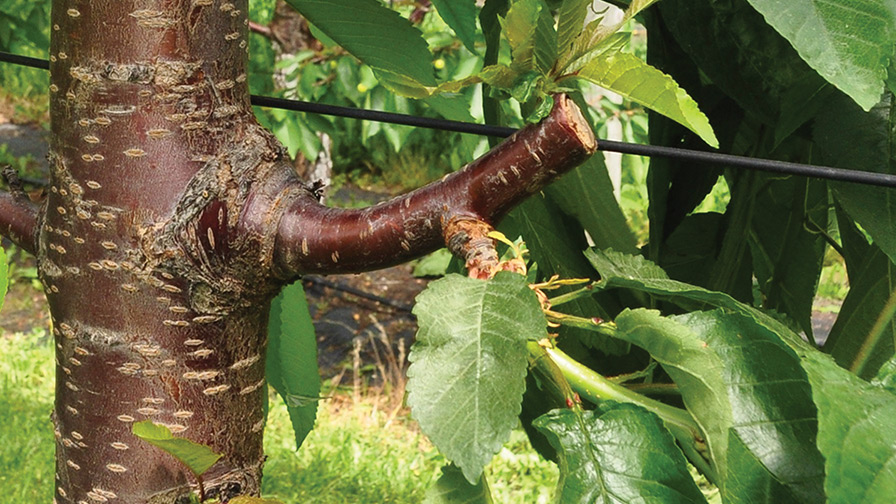Why Renewal Pruning is Good for Your Sweet Cherry Orchard

To maintain fruit quality, continuously remove and replace fruiting wood as it ages beyond its prime. Pictured is an example of sweet cherry shoot renewal. (Photo: Greg Lang)
You’ve seen many columns on establishing orchards with different training systems to achieve a variety of canopy architectures. Once the canopy architecture decision is made, and the orchard planted and trained, the desired canopy structure must be both maintained and renewed to optimize sustainable production for years, even decades, to come.
One of the most common questions growers ask who are contemplating higher density sweet cherry orchards, particularly on dwarfing rootstocks is “Will the productive life of the orchard be shorter than a more traditional orchard on vigorous rootstocks?”
The answer centers squarely on the concept of renewal vs. maintenance pruning. In traditional orchards on vigorous rootstocks, with a central leader or multiple leaders, annual dormant pruning is conducted primarily to remove excessive growth and maintain tree structure.
Excessive growth interferes with light distribution within the canopy, which causes shading. Shade leads to loss of both vegetative growing points and fruiting spurs, and a significant gradient in light from the canopy periphery to the canopy interior also results in a similar gradient of fruit ripening and quality. The poorest quality fruit generally are those on the oldest, most shaded spurs, resulting in lower fruit sugar levels and firmness than more sun-exposed fruit.
On vigorous rootstocks, dormant pruning to maintain canopy structure and remove excessive annual growth naturally generates a lot of new regrowth, and thus new future fruiting sites. This results in leaf-to-fruit ratios that are favorable for good fruit quality.
Postharvest summer pruning is another effective way to open up vigorous canopies to maintain better light distribution at the time when flower bud differentiation begins. This means improved flower bud quality for the next season. Summer pruning can reduce regrowth vigor somewhat since late season leaf area is removed, which otherwise would contribute to storage reserves of carbon and nitrogen for the next spring’s growth. Summer pruning prior to harvest often generates regrowth later that same season. But, summer pruning postharvest usually doesn’t produce regrowth of any consequence, except in long-season climates like those of California.
Renew to Maintain Fruit Quality
For sweet cherries on dwarfing rootstocks that are trained to high-density systems, excessive, shade-inducing vegetative vigor may be much less of a problem. In such situations, dormant pruning to reduce crop load and renew, or invigorate, new annual shoot growth, which will form new, young future fruiting sites, becomes more important to achieve high fruit quality and production longevity. This annual renewal of fruiting wood is recognized as critical to maintaining optimized yields and fruit quality as high-density sweet cherry orchards age. To maintain fruit quality, continuously remove and replace fruiting wood as it ages beyond its prime.
In the NC-140 Training Systems and Rootstock trial at Michigan State University (MSU), renewing to maintain fruit quality was addressed by annual removal — pruning back to a stub — of one or two of the largest fruiting units, such as the oldest upright mini-leader in Kym Green bush (KGB) and upright fruiting offshoots (UFO) trees, or the oldest lateral branch from tall spindle axe (TSA) trees.
In contrast, for the super slender axe (SSA) training system, 100% of the lateral fruiting branches are renewed every year, with each being stubbed back to basal flower buds, plus 1-3 vegetative buds for re-growing at least one new lateral shoot per old fruiting shoot. Besides using this extreme pruning to accomplish 100% renewal every year, the basal fruiting sites tend to yield the highest quality fruit.
What became apparent during the course of the NC-140 trial is that the task of selective renewal of the oldest fruiting units can be more challenging on highly productive, vigor-limiting rootstocks, since the fruit crop load competes strongly with new shoots for growth resources like carbohydrates.
Research that Dr. Marlene Ayala, Professor of Sweet Cherry Physiology and Breeding at Catholic University in Santiago, Chile, conducted in my lab during her MSU graduate studies, showed that carbohydrates produced in cherry spur leaves during spring and early summer were used primarily by developing fruit, with minimal amounts available for shoot growth of trees on dwarfing rootstocks.
Timing Influences Response
The ramifications of this situation, in which large fruit loads outcompete vegetative growth, have been observed by many cherry growers and researchers when renewal shoot initiation is poor or highly variable from tree to tree. In a 2015 fruiting wood renewal study at our MSU-Clarksville Research Center, we examined the timing of renewal pruning for UFO-trained ‘Rainier’ cherries on the very dwarfing, very productive rootstock, Gisela 3. The best results occurred with pruning at bloom, compared to pruning late in dormancy or 7-10 days before or after bloom; these results concurred with similar results found several years ago by Dr. Matt Whiting at Washington State University.
However, even at the best timing, when the oldest ‘Rainier’ on Gisela 3 (Gi3) fruiting upright shoot was cut back to a stub of several inches, only 30% of the pruning cuts initiated renewal shoots, due to competition with the crop load. Growth of the renewal shoots — those that did emerge — stopped after only about an inch of extension, due to the strong competition with the crop in the rest of the canopy. Thus, when only a minor proportion of the canopy is renewed in higher density training systems on quite dwarfing rootstocks like Gi3 or the MSU rootstocks (Clare, Cass, Clinton, Crawford, and Lake), or on semi-dwarfing rootstocks like Gi5 in some situations, achieving consistent, adequate renewal growth can be challenging.
The radical 100% renewal pruning of the SSA training system usually results in excellent regrowth of shoots — providing at least one vegetative bud remains on the SSA-pruned stub. This reduces crop load by minimizing spur fruiting sites and retaining mainly non-spur basal flower buds.
What might be done, then, to improve renewal pruning results on vigor-limited rootstocks in high-density systems? One radical idea, that we have been testing since 2016, will have to be explored in the next column.










